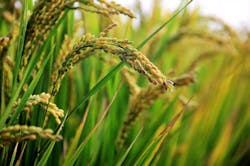Rice farmers in Nepal are improving yields while reducing water usage using a technique that sows fewer plants per acre while producing more rice per plant. The technique, called the system of rice intensification (SRI), may provide a solution for water scarcity throughout the region.
According to NPR, SRI can improve yields by more than 50%. Developed in Madagascar in the 1980s, the system involves planting fewer seedlings, planting them younger and using less water. While some Nepalese farmers are reluctant to try the new method, the rice plants are proving to yield more crops when their roots have more room to grow. SRI also holds appeal with farmers because there is no need to invest in new technology or buy new seeds.
Climate Researcher Sonali McDermid for New York University is collaborating with researchers from the Tamil Nadu Agricultural University to investigate whether SRI may provide benefits in the face of global water shortages.
“I’ve seen estimates of about 25% reductions in water consumption all the way to 50 or 60% reductions in water consumption,” McDermid told NPR.
The researchers are working on test plots in India and Latin America to isolate the aspects of SRI that work for poor farmers. The team will then use climate models to assess how the practice will work in drier climates. The researchers cite longer root systems as key to creating water resilient plants.
Listen to the full story here.






